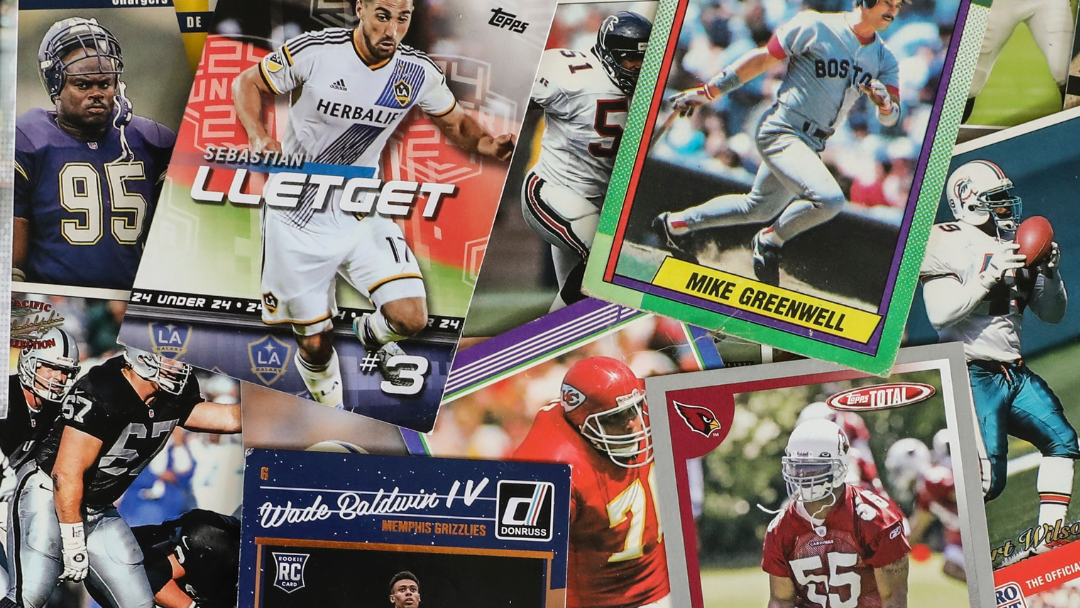IT’S FRIDAY NIGHT IN AUGUST AND ONE-HUNDRED AND EIGHTY-THREE PEOPLE ARE WATCHING A LIVE STREAM of two men in Rochester, New York open a thirty-thousand-dollar box of National Football League trading cards. Nine viewers in the chat purchased a stake in the box for three-thousand US dollars apiece (one viewer purchased two spots). The box contains ten cards. Once all ten cards in the box are revealed on camera, the purchasers will be put into a random order and be allowed to select a card one at a time until every card has been claimed.
The two men opening the box are from a brick-and-mortar card shop in Rochester. Although they have a physical location, much of their revenue comes from box breaks on the mobile and web app WhatNot. Box breaks operate in a similar way to the one they are doing tonight, but are slightly different: a person (hereby known as a breaker) acquires a large amount of sealed sports cards, they show what products they are going to open (“rip” or “break” in the nomenclature), then they sell or auction a spots that correspond with teams in the league. Finally, they open card packs live on camera. Those cards are mailed to the customers who purchased the spots. For example, if you purchased the Cincinnati Bengals, you receive every Bengal card that is revealed on camera. If no Bengals were revealed (or “pulled”), then you’re out of luck.
But tonight, in this break, things are different. The breakers are opening a product called Eminence which might be the gaudiest sports card product ever released. The sealed box contains ten short-printed cards, including some autographs from current NFL stars and Hall of Famers from the sport’s past. Randomly inserted into these boxes – only 175 boxes were made – are cut autographs as well. Cut autographs are old autographs that were literally cut out of one item and sealed in an Eminence card. These one-of-a-kind cut autos are from deceased sports stars, politicians and entertainers. The linebacker Pat Tillman, who famously volunteered for the Iraq War and was killed by friendly fire, has an autograph in this set. So too do former presidents Franklin D. Roosevelt and Ulysses S. Grant, comedians Robin Williams and Norm Macdonald, among others. Some cards from modern players like Tom Brady or Dak Prescott have embedded bars of silver, gold, and platinum alongside the player’s photo and signature. If it all sounds grotesquely decadent, it’s because it is. But it’s symbolic of what the card collecting hobby has become: bizarre, high-stakes, and one that requires collectors working together. Whether you see a live stream like this as democratic by making a thirty-thousand dollar box of sports cards slightly more accessible for a fraction of the price or as cynical exploitation of degenerate gamblers will largely depend on perspective.
Much ink has been spilled about the trading card market in the last two years. In case you haven’t read about the eye-popping numbers some cards are fetching at auction, here’s a brief summary of what has happened since early 2020: Due in part to demand-induced boredom during early pandemic quarantine and scarcity of sealed product, the card market exploded. This primarily affected Pokémon cards and sports cards. An armchair psychologist might posit that an adult’s renewed obsession with Pokémon cards was a result of the mental and physical pressures of trying to survive through cataclysmic event like a pandemic and a yearning to return to the simpler times of their youth. For sports fans, cards were a good way to connect to the games they loved when all major sports leagues were put on hiatus. You probably saw the news stories about rare Charizard cards fetching hundreds of thousands of dollars at auction. Or maybe you heard about the rapper Drake buying hundreds of thousands of dollars-worth of basketball cards in hopes of finding a rare LeBron James card. If a rising tide raises all boats in the water, these publicized examples fueled a tsunami, and a many new consumers have tried to ride the wave in.
The market has cooled in the last two years but the effects of the boom still remain. To counter demand, card producers, specifically Panini who holds the licenses to the NFL and the NBA, dramatically ramped up production and flooded the market with sealed product. There are thousands of new and former collectors who were introduced or reintroduced to the hobby during the boom period who stuck around. These consumers are spurred by cottage industries of content creators who create an itch that needs scratching by opening sealed product on camera. Communities around these creators become both competitive and collaborative with one another – not only bragging about some grail they recently purchased or found in a pack, but also helping their fellow collectors secure their cards they are chasing as well (by selling or trading with them).
Not all breakers are local card shops. Many of them are solo operations. WhatNot, like many upstart social media platforms during their aggressive audience acquisition phase, is relatively untouched by major corporations or brands. They have recently made attempts by paying appearance fees for Post Malone, ex-NFL linebacker Blake Martinez, and others to appear on the platform, but there are no ads on the platform during streams. No major corporations, like Target, have their own channels. WhatNot also doesn’t seem to suggest channels by algorithm. When you login, you can see everyone who is selling and they are sorted by the type of product (Funkos, Sports Cards, Vintage Clothing, Vinyl Records, etc.) and by number of viewers watching. Other than major giveaway events by minor Youtube stars like Packman, viewership on a single video rarely gets more than a couple concurrent hundred views. The majority of operations are low-rent, with double digit viewers (sometimes less than forty), from collectors who are treating buying and selling cards as a side hustle. This is the gig economy after all.
This channel is not low rent. It can’t be when there is a thirty-thousand dollar box of cards on the table. Most content creators in the card collecting community are a cross between crypto bros, rigidly traditional sports enthusiasts, and door-to-door salesmen. They often have the delusional optimism of a crypto believer, generously speculating on a cards value and its ability to make them rich. Some have a kind of desperation of a door-to-door salesman on a cold streak, needing to make back the initial investment they made in the sealed product to open. The two on this channel – let’s call them Hayden and Jake – seem to be, primarily, sports enthusiasts, with a dash of carnival barker. Hayden is the channel’s main host. He projects his voice to a near shout throughout the show and by the end he sounds hoarse, his voice cracking slightly. He is relentlessly positive and adept at planting hope in a customer’s imagination. With Jake as his color man, they steer the chat and the audience into the joy of collecting and downplay the money that has been spent or can be earned. That is, until it’s convenient for them to speculate on the value of a card they just pulled.
Throughout the stream, the hosts pepper in catchphrases the chat has come to parrot. One of the best examples of the channel’s optimism is when a less-than-desirable team (let’s say the Cleveland Browns) is drawn and the person who spent, admittedly, a lot of money, is stuck with them. Hayden will nevertheless rattle off what someone can find from that team in the box and then he’ll say, “We take those!”
“We take those!” works on a number of levels. It subtly agrees with the buyer’s disappointment and empathizes with them. As if to say, “this is what you got, but it’s not the end of the world.” The buyer should keep their head up – anything can happen from a break and any card could be pulled. Panini might weight the boxes toward more desirable teams and players, but every team in the NFL has some kind of card to chase in these boxes. After this phrase is uttered another, an equally malleable one, is said: “And we move!” Meaning, even if this is a loss, move on from it, don’t think about it. You’ll get ‘em next time.
There are regular customers who speak to Hayden and Jake with familiarity, asking about things mentioned on previous streams. One would hope they are people who can afford to spend three-to-four hundred dollars a couple times a week on the prospect of sports cards. Or perhaps they are fellow buyers and sellers and this is how they acquire product to flip. But one can’t help but wonder how many of these customers are compulsive gamblers. Hayden and Jake can be forgiven for feeling awkward when new buyers are disappointed – my sympathies don’t lie with someone who hammers a button that says “BID $300” and not know what they are buying – but to do these breaks over and over each day, multiple times a week, means there must be a customer base that is loyal and, again, all this is speculation, it seems unlikely to me that all these customers are wealthy enough and spending their money on a mobile app for sports cards.
The same rush I get from opening a pack of cards is the same rush I get from placing a bet. The possibility of losing money is scary but it is often outweighed by the potential for gain, which is why I need to be careful about what I spend and how often I do it. When I bought in to a break on this channel for $299 ($324 after tax and shipping) I received the Pittsburgh Steelers and ended up with, after nearly $8,000 of sealed sports cards were opened, two $5-to-10-dollar cards and two base cards worth less than a dollar each. There was a temptation for me to buy into the next break, to “run it back.” I stared at the bid button and, if a bid seemed low (the ridiculous fallacy that it was “a good deal”), I hovered over the left click button on my mouse. Some of that temptation came from a desire to get a card of note, to feel once again like a winner, but other temptation was simpler: it had been fun and I wanted to keep having fun.
It seems unlikely that many people in this break for Eminence will make their money back. But it’s a guarantee that they are having fun, or at least enjoying the attention. For a scant thirty minutes, they are kings among the viewers. Hundreds of people heap praise on them for their gumption, for having the money in the first place (we love the rich as much as we hate them, after all). This is the beauty of potential. Because once the box is opened, the actual winners – those who broke even or at least made their money back – will be crowned and the suckers who just pissed away three grand will be razed.
Six months later, I cannot remember a single name of a purchaser. I cannot remember a single card that was pulled from the break. A box of Eminence can be purchased online at a discounted rate of sixteen-thousand-dollars on DaCardWorld.com. Some Eminence cards can be purchased for less than two-hundred dollars a piece on eBay.
I often wonder if Hayden and Jake and other breakers are doing anything morally suspect. What they are doing is perfectly legal, of course. But should it be? Gambling is at least regulated, even though gamblers are not. A gambler can lose their entire life’s savings in a casino and, in the eyes of the law, the casino nor the gambler have engaged in any illegal activities. The breakers show their gratitude for loyalty by talking up the returning users when they buy in. They do so with newbies too, consciously or unconsciously grooming the next generation of repeat spenders. When I purchased the Pittsburgh Steelers, I was repeatedly told “Welcome to the family,” as if spending a few hundred dollars was akin to a blood relation.
But what of Panini? They have specifically printed sets that are full of manufactured rarity and then fill the sets with monstrous base sets or low-value inserts, patches, and autographs, so consumers are searching for needles in haystacks. Consumers will rarely receive the same value back on their purchase and, almost always, lose money as they chase the cards every other collector wants. The basic structure of this practice has been around since the beginning of sports cards – when they were randomly inserted into tobacco tins as a means of promotion and, let’s face it, to facilitate addiction. Panini has attempted to dispel some of the accusations of overprinting that haunted the industry eighties and nineties by including many cards with print numbers on them. But it also feels as though they are simply catering to the Youtubers and content creators of the world. They want people to open packs on camera and give their O face and then plant that itch on consumers who want the same feeling.
A box that may have cost $200 three years ago now costs $500, and that’s not just because of inflation. Spending hundreds of dollars on unopened product is not a realistic enterprise for the common collector. This loss of value wouldn’t be an issue (almost every product you buy dramatically loses value as soon as you walk out of the store, after all) if there wasn’t so much attention paid to the possibility of buying low and selling high. Card collecting in 2022 is a buyer’s and seller’s market. Even though Panini does not directly profit off of third-party transactions it benefits by keeping people engaged with the possibility of finding a highly prized card and selling it to become rich. Sellers have the opportunity to get in front of buyers more than ever before – between WhatNot, eBay, Facebook marketplace, Instagram, and so on. Selling is not only possible, it’s extremely easy. This has led to a gold rush attitude, where consumers are hoping they find a vein on the right hill. I’ve seen many breakers and consumers talk in chat excitedly about finding a card they can retire on, as if that’s realistic. In truth, most card collectors are in their 20s, 30s, and 40s and few cards in the world go for more than a thousand dollars, let alone tens or hundreds of thousands of dollars. There are almost no cards in the world that they are going to find by accident that will equate to decades of salary or compounding interest.
Like any subculture that experiences a boom in popularity, sports card collecting is beset with gatekeepers as well as those looking to exploit a moment in time for financial gain. As someone who was rabid about collecting in the late nineties and early two-thousands as a wee lad in rural Michigan, I more closely align with the former. I am rueful of the “collectors” who fixate more on players that sell (ex: rookie quarterbacks) than players they actually root for and care about. I’ve seen far too many people in chat try to explain why it is better to pull a rookie quarterback who may never see the field of play than it is to receive a Super Bowl winner in their twilight years.
I am not ashamed to say that I experienced schadenfreude watching these breakers open Eminence and seeing the despair of those who purchased a stake in the break and were left holding the bag. I am ashamed to say that the only thing I wanted more than to watch it all burn down, was three-thousand dollars, so I could feel like a king for thirty-minutes.
PIERCE COURCHAINE was born in Milwaukee, Wisconsin. He is a graduate of the Missouri School of Journalism. His work has appeared or is forthcoming in The Chronicle of the Horse, Mount Hope, and The Santa Clara Review. He is working on a novel.
Like what you’re reading?
Get new stories, sports musings, or book reviews sent to your inbox. Drop your email below to start >>>
NEW book release
Ghosts Caught on Film by Barrett Bowlin. Order the book of which Dan Chaon says “is a thrilling first collection that marks a beginning for a major talent.”
GET THE BOOK



